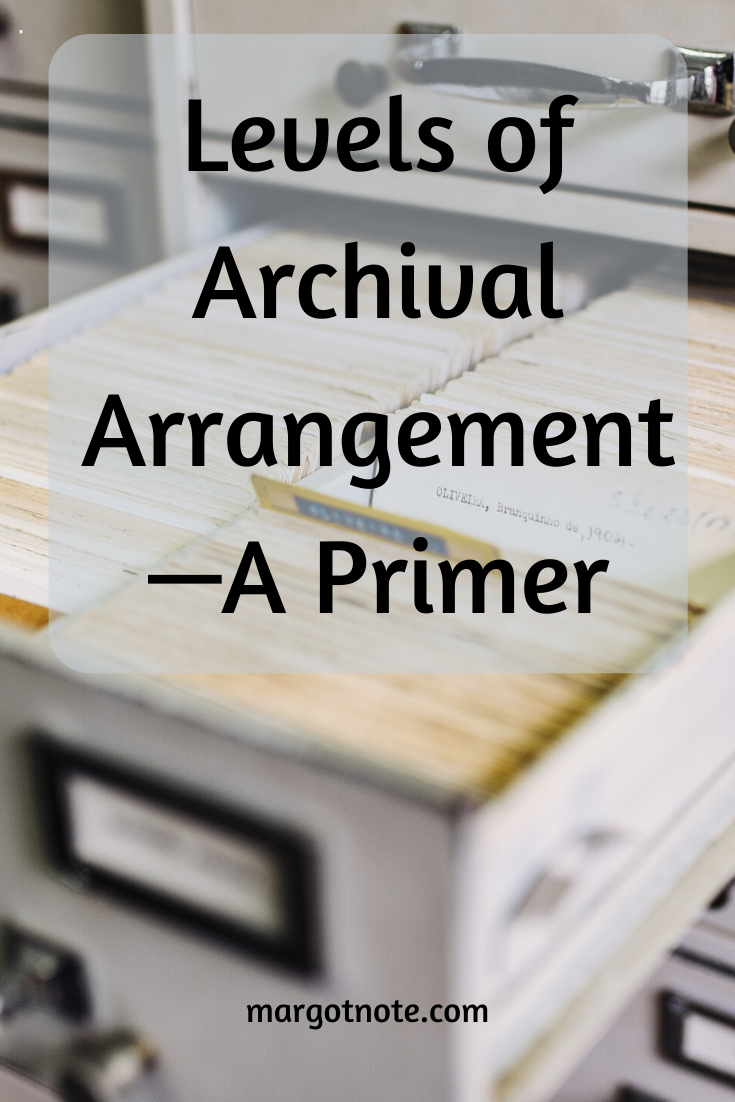To establish context when performing arrangement, archivists start with an understanding of the overall body that produced the records. Archivists keep evidential and information values in mind to create a scheme that protects both. As part of archival collections management, they also think about audiences, as archives usually have more than one.
Archivists start with the whole and then move towards an understanding of the parts of the collection. The realities of the materials’ volume and staff size will determine what’s done.
The traditional approach to arrangement goes back to archivist Oliver Wendell Holmes and an article in a 1964 American Archivist, where he discussed five levels of arrangement.
The Repository
The first is the repository level. This level pertains to arrangement into overall divisions or collections; sometimes, it relates to the physical layout within a repository. A repository may be divided into public records and manuscripts or might have a separate subject-related unit for literary manuscripts, or labor collections, or the like. In larger institutional archives, divisions like an organizational chart may exist.
The Record Group or Collection
The second level is record group or collection, which is the basic organizational unit by provenance, about a body of organizationally related records. There can be no overlap, so sometimes smaller, related agencies are kept together if it’s hard to separate them from the records of the larger group.
Record group is the National Archives term also used by other institutional repositories. Collection is a more generic term, used for manuscript collections but also institutional records in many settings.
Subgroups occur if there’s a major subdivision, such as a family collection with subgroups for the papers of individual members of the family. Sometimes personal papers contain a subgroup for organizational records that need to remain a part of the larger aggregate. All subgroups have a common origin in the larger record group or collection.
Series
Series, the third level, is the most important one in terms of arrangement. The series level indicates the real organization of the collection, and it’s a significant focus area for description.
Series aren’t always obvious, so look for a common denominator in terms of subject, provenance, or record types. Materials within a series are related by creation, activities, use, or form; they are filing units in a consistent pattern.
Once the series are determined, you need to decide on the order in which they will fall into the overall collection. You may have ten series, but one of them must come first in terms of physical containers and in terms of listing in the finding aids. You move from the most important series, the ones closest to the purpose of the records creators, to the least significant records. Archivists also move from general to specific.
File Unit and Document
The file unit is the next level. A series can be one folder, or it can be hundreds of boxes, and there are different schemes for sequencing those files:
Chronological is the most straightforward and objective. Chronological arrangement shows the relationship between the documents and the events that surround their creation. However, dates aren’t always obvious. Chronology splits ownership and separates letters and responses.
Alphabetical is used more frequently for literary materials or retained if it’s the original order. Alphabetical arrangement keeps letters and responses together but makes it harder to trace activities.
Combination is useful when the original order means that the incoming documents are alphabetical, and the outgoing files are chronological.
Subject arrangements are retained when they’re the original order and reflect the records creators’ projects or style of work. Subject arrangement often occurs in the papers of scholars, researchers, and journalists. Archivists, however, don’t create subject files since one document can have multiple subjects. The arrangement destroys context, and doing so inserts the archivist’s opinion where it doesn’t belong.
The last level is the document. Item-level arrangement is unnecessary and should rarely occur. Often my clients think that their collections must be organized individually, and then they become overwhelmed.
A Traditional Approach
Provenance informs the first two levels, while original order affects the last three. The five-level scheme is traditional, and some archivists feel that it no longer works. One problem is that a body of records can only be assigned to one collection or record group. The function that created a specific series of records can shift from one office to another over time, bureaucracies change, and the five levels don’t always work well.
A New Paradigm
Some have suggested a new paradigm: that records aren’t created by a single body and don’t fall into a hierarchical arrangement with each other. Instead, records are created in a complex bureaucratic network that may have a hierarchy. While the organization may have a hierarchy, the records don’t have a hierarchy. While archivists determine the best way to arrange contemporary records, the five levels of arrangement can still be a useful way to view this process.
The blog was originally published on Lucidea's blog.































